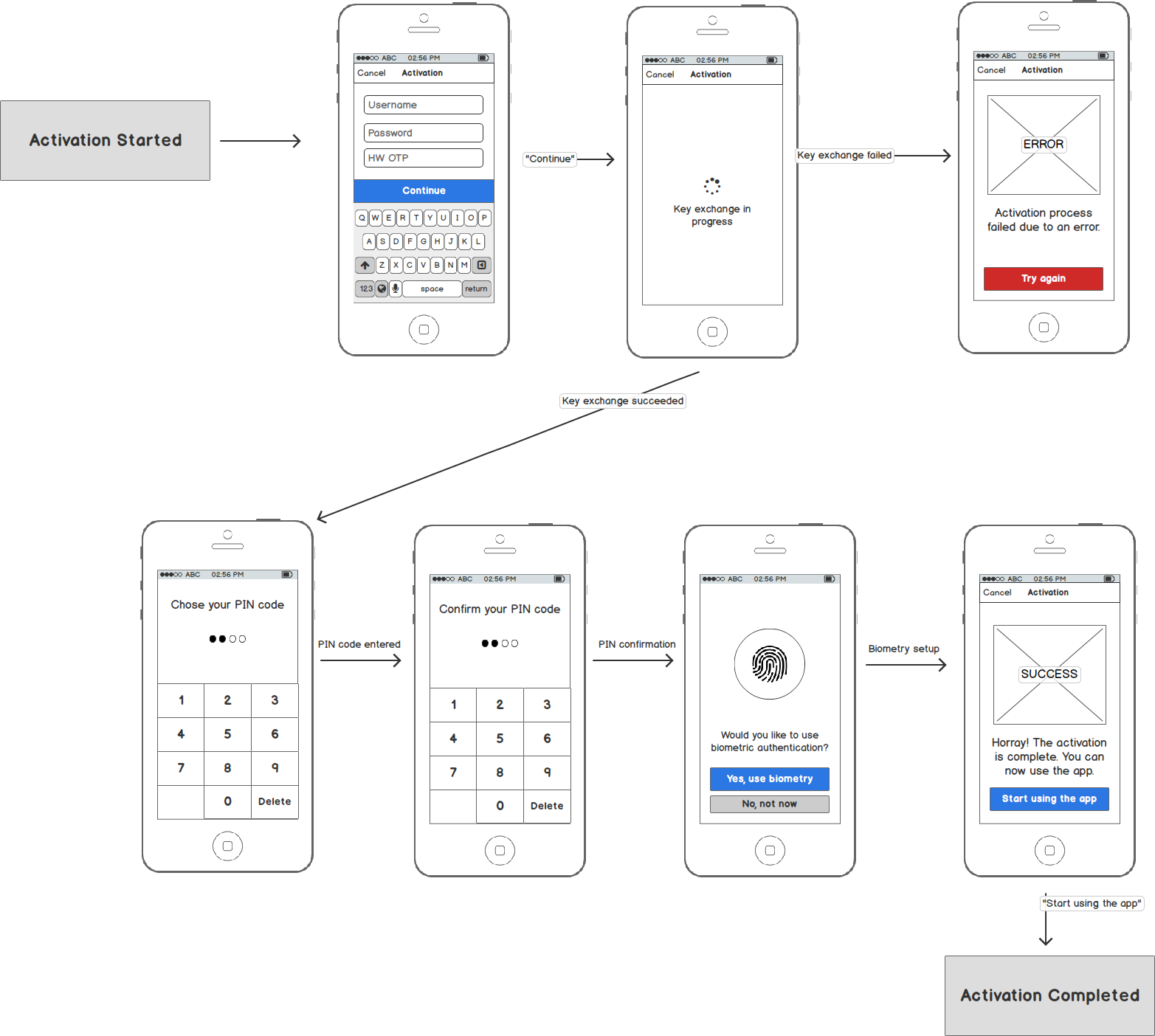Activation via Custom Credentials
The most flexible type of activation is “activation via the custom credentials”. In this flow, the credentials is provided as a key-value map. Enrollment Server is then responsible for verifying the credentials with an external service that returns a user ID in response.
Example User Flow
From the user perspective, activation via custom credentials is performed as a sequence of steps in the mobile app. The following diagram shows example steps in the mobile banking app.

Sequence Diagrams
The sequence diagrams below explain the PowerAuth key exchange during activation with custom credentials. It shows how an app with PowerAuth Mobile SDK, Enrollment Server and PowerAuth Server play together in order to establish a shared secret between the client mobile application and the PowerAuth Server.

Process Description
-
User enters the credentials identity attributes
IDENTITY_ATTRIBUTESin the app with PowerAuth Mobile SDK. The entry can be manual or fully/partially handled using other mechanism, such as deeplink. - PowerAuth Mobile SDK generates its key pair
(KEY_DEVICE_PRIVATE, KEY_DEVICE_PUBLIC).KeyPair keyPair = KeyGenerator.randomKeyPair() PrivateKey KEY_DEVICE_PRIVATE = keyPair.getPrivate() PublicKey KEY_DEVICE_PUBLIC = keyPair.getPublic() -
PowerAuth Mobile SDK encrypts the payload containing
KEY_DEVICE_PUBLICwith an application scoped ECIES (level 2,sh1="/pa/activation"). Let’s call the result of this step asACTIVATION_DATA. -
PowerAuth Mobile SDK encrypts payload containing
ACTIVATION_DATAandIDENTITY_ATTRIBUTESwith an application scoped ECIES (level 1,sh1="/pa/generic/application") and sends HTTPS request to the/pa/v3/activation/createendpoint. -
Enrollment Server decrypts the ECIES envelope, with an application scoped ECIES (level 1,
sh1="/pa/generic/application"). -
Enrollment Server obtains
IDENTITY_ATTRIBUTESand verifies the identity attributes using own custom processing logic. As a result of this processing, Enrollment Server obtains aUSER_IDvalue representing a unique identifier of the user with provided credentials. -
Enrollment Server calls PowerAuth Server with
ACTIVATION_DATAandUSER_IDvalue. -
PowerAuth Server receives
USER_IDandACTIVATION_DATAfrom Enrollment Server. -
PowerAuth Server decrypts
ACTIVATION_DATAusing an application scoped ECIES (level 2,sh1="/pa/activation"), creates a new activation inPENDING_COMMITstatus for the user with providedUSER_IDand storesKEY_DEVICE_PUBLIC. - PowerAuth Server generates its key pair
(KEY_SERVER_PRIVATE, KEY_SERVER_PUBLIC).KeyPair keyPair = KeyGenerator.randomKeyPair() PrivateKey KEY_SERVER_PRIVATE = keyPair.getPrivate() PublicKey KEY_SERVER_PUBLIC = keyPair.getPublic() - PowerAuth Server uses
KEY_DEVICE_PUBLICandKEY_SERVER_PRIVATEto deduceKEY_MASTER_SECRETusing ECDH.KEY_MASTER_SECRET = ByteUtils.convert32Bto16B(ECDH.phase(KEY_SERVER_PRIVATE, KEY_DEVICE_PUBLIC)) -
PowerAuth Server encrypts response, containing
ACTIVATION_ID,CTR_DATA,KEY_SERVER_PUBLICwith the same key as was used for ECIES level 2 decryption. This data is one more time encrypted by Enrollment Server, with the same key from ECIES level 1, and the response is sent to the PowerAuth Client. -
PowerAuth Mobile SDK decrypts the response with both levels of ECIES, in the right order and receives
ACTIVATION_ID,KEY_SERVER_PUBLIC,CTR_DATAand stores all that values locally in the volatile memory on the device. - PowerAuth Mobile SDK uses
KEY_DEVICE_PRIVATEandKEY_SERVER_PUBLICto deduceKEY_MASTER_SECRETusing ECDH.KEY_MASTER_SECRET = ByteUtils.convert32Bto16B(ECDH.phase(KEY_DEVICE_PRIVATE, KEY_SERVER_PUBLIC))
Implicit Activation Commit
Enrollment Server may automatically commit activations via custom credentials - typically, this is the desired behavior. As a result, the activation will immediately switch to the ACTIVE status.
However, if the particular use case requires different handling, the enrollment server behavior may be customized and activation can remain in PENDING_COMMIT state until it is committed by calling the commit service.
Related Topics
- Activation via Activation Code
- Activation via Recovery Code
- Checking Activation Status
- Key Derivation
- Additional Activation OTP
